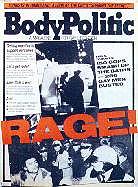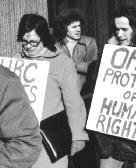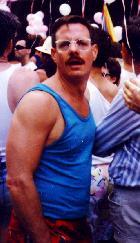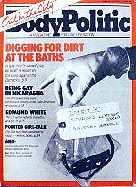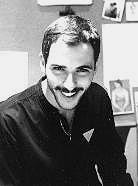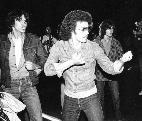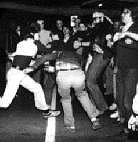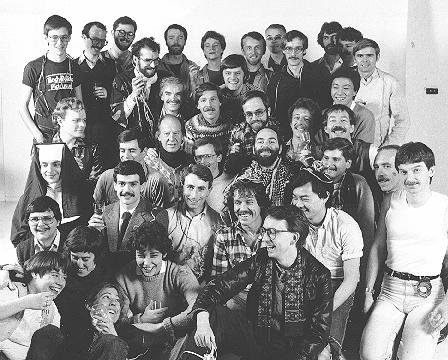|
Promiscuous |
|
Raids / Rage February 5 & 6, 1981
Subtle we were not:
Fort Cop:
|
"We come right up to them. SEIG HEIL! we shout, give them the Nazi salute. NO MORE SHIT! FUCK YOU 52! the chants go. PIGS!
"Old memories floating around in my head.
"Cops pulling me out of gay bars to check my ID, the same ones who've done it time & again before. Snickering over names & messages they find in my wallet. Trying to humiliate me.
"Cops dragging people past me, out of the Parkside & Bloor subway washrooms.
"Cops telling me to move away or they'll arrest me, as I try to sell a gay newspaper to gay people outside a gay bar.
"Now for once they have to stand there & take it from us."
Peter Zorzi
on the night of Feb 6, 1981, at 52 Division -- yet again capturing the moment in Queer Catharsis, 1992.
1981
At 11 pm, Thursday, February 5, 1981, 150 cops simultaneously swept down on four Toronto baths: The Club, The Romans, The Richmond Street Health Emporium and -- again -- The Barracks.
Over the course of the night and into Friday morning, they busted 266 men, charging them as found-ins, and another 20 as keepers. Now this was the biggest mass arrest in Canada since the October Crisis of 1970. Later keeper charges would bring the total to more than 300.
Tales of that night became legend: the places pillaged, doors and walls kicked in, mirrors smashed, mattresses ripped to shreds. Total damage was later estimated at more than $35,000. The Richmond, the city's most glamorously appointed bath, would never open again.
Men were lined up naked, their room numbers gouged into their hands with pens. Their genitals were examined, each made to turn and spread his cheeks. They were threatened with compulsory VD checks -- though one had been there to offer voluntary tests free: TBP's Robert Trow, working as he had since 1976 for Hassle Free Clinic. He was charged too. Cops made Vaseline jokes, called patrons "fucking faggots," checked for wedding rings, asked who was married. "You'll wish you stayed at home with your wife tonight, you fucking queer."
Most notoriously, rounding men up into a shower room, one said: "Too bad these pipes aren't hooked up to gas."
But more legendary is what happened next. The next day, the next night, and many days and nights beyond.
By noon on Friday people from the RTPC and other groups had met at TBP's office. Most had been up all night, rushing by cab from one bath to the next and finally to 52 Division, where those arrested had been carted off. Somehow we had to respond. Fast. By 4 pm things were in place: a sound truck; marshalls from the gay self defence course; a demo announced by 4,000 leaflets that runners got out to the bars.
"Enough is enough," it read. "Protest. Yonge and Wellesley. Midnight tonight." We had no idea how people would react. I later wrote of that day:
- It was winter. We were issuing a call to come out into the freezing dark. I wondered if it would work. This was about the baths, after all, about sex, about things that many gay people, even if modestly out, might still want to keep in the closet. Would they come out now, into the cold, for this?
None of us knew. Chris Bearchell later recalled being with Jim Monk, Windsor activist, TBP's correspondent there, trudging toward Yonge and Wellesley, wondering what they'd find. "Fifty people?" she said. "Five hundred?" Four hundred had come out, by day, to protest the Barracks raid in 1978.
Chris and Jim found maybe 300 there at midnight, chanting "No more raids!" and "Stop the cops!" A half hour later there were 1,500 spilling into Yonge Street, taking it over, the cops powerless to stop them. The bars emptied along the way: now there were more than 3,000, yelling, chanting, shrieking whistles, roaring south. Chris led a new chant, one we'd slap on stickers and buttons soon seen all over town: "NO MORE SHIT! Gays fight back!"
The crowd was angry, tussling with cops, who'd set up a roadblock of cruisers at Dundas. Two men climbed up and pissed on them (fitting: Toronto cop cars then were yellow). A windshield was smashed; headlights kicked in. Windows on a streetcar were thwacked at, shattered.
Target: the hated 52 Division, just along Dundas. The crowd swept in -- smack against a phalanx of nearly 200 cops guarding that concrete and glass fortress, some even up on its roof. The whole place glowed in the lights of TV cameras, catching placards with swastikas, shouts of "Sieg Heil!"
But the chant that took over the crowd, roared endlessly, needed no historical referents: "Fuck you, 52, FUCK YOU, 52!"
Then the chant turned: "Queen's Park!" The Ontario legislature, perhaps a more fitting target, was just up University Avenue. A sea of protest surged up and charged the doors -- great booms on unyielding oak the last straw for the police. They pushed in swinging, punching, kicking people back. Some took off their badges to prevent being identified. Cop brass later denied that. In our next issue we'd run a picture to prove it.
The whole thing fizzled at Yonge and Bloor, stray protesters outnumbered by cops and hostile kids. With a few more tussles it was over, finally, at 2:30 am.
Quite a night. And I missed it. I'd been out the night of the raids, one of those people rushing around in cabs. But I had an issue of The Beep to get done, its press date the next Tuesday, a week's work put in already. Now there would be a week more.
Three pages of news already laid out were scrapped, the planned cover tossed out and replaced with shots of the busts, the demo, and one big word over them in orange: "RAGE!"
Mikey had been out on the demo of February 6. I'd worried about him. He called me once during that grinding week of production to say he'd overslept at a trick's place, too late to get home by the time I, at last, would be. I was furious: screwing around was fine; screwing off on me at a time like this was not.
Friday night February 20: another demo, 4,000 roaring from Queen's Park down to 52 Division. By then there'd been time to gather support, Tim McCaskell key in that: speakers that night included the head of the city's labour council and a black woman whose husband had been shot by the police.
By now we had banners, the biggest leading that parade: "Enough is enough. Stop police violence." Photos later printed in the big dailies identified four of the people carrying that banner as cops, plainclothes and undercover. Others had hoisted placards, some started fights.
On the cover of our next issue we'd uncover another agent provocateur, putting a big red circle around his face in a crowd protesting outside police commission hearings on February 12. The drawline: "The enemy in our midst."
Margaret Atwood tapped a deeper root: "institutionalized contempt." Why did the police raid the baths? Why do schoolyard bullies beat up little kids?
"Because they can."
They hinted at links to organized crime, later charging some alleged keepers -- George Hislop among them, again -- with criminal conspiracy. Jack Campbell, Miami based head of the Club Bath chain, was also charged. He later flew into town, made a plea bargain, paid a $40,000 fine and flew right back out -- his Canadian co- defendants left to twist in the wind. But in time they got off, neither conspiracy nor touted Mafia links ever proven.
Some said redneck renegades within the force were battling the top brass: the new chief was reputedly a liberal. In part that would turn out to be true. But many doubted such massive police action could have come down without a nod from higher up. Much higher: Ontario's Tory attorney general Roy McMurtry, nemesis of TBP; perhaps even premier Bill Davis himself.
The Tories had ruled the province since 1943 (a reign twice as long as Genghis Kahn's) but for the last while as a minority government, the Liberals and mildly socialist New Democrats splitting most of the legislature's seats. There was an election set for March 19. The raids might have been staged to prove the Tories tough law and order guys -- and, after near panic during the Hislop campaign, to tar the opposition as "pro gay."
The New Democratic Party had been, mostly. But after Hislop's and Sewell's defeat the government introduced a bill to amend the human rights code, raising again the spectre of that "horribly menacing homosexual lobby." The NDP quivered. Claire Hoy was pleased to report in The Sun that the party's leader had said gay rights were "not a priority at this time."
Gay people abandoned the NDP in droves; in an editorial we said their initials stood for "No Damned Principles." George Hislop ran against them as a protest candidate. He lost but so did the NDP, dropping from 33 seats to 21. The Tories got their majority, going on to reign over Ontario until 1985.
It was novelist Margaret Atwood who touched on the deeper roots of the raids, speaking at a March 6 Gay Freedom Rally. She got great laughs with lines like: "What have they got against cleanliness?" and "I know that if I were taking a bath..." -- the crowd's happy roar finishing that bit for her.
But her most telling point wasn't so funny. No people, she said, should the subject of "institutionalized contempt." Why did cops raid the baths? Well, why do schoolyard bullies beat up little kids?
"Because," she said, "they can."
Few gay militants grasped how they'd got ready, "merely social" activities not seen as "real" politics. But it was the essence of politics: people coming together to meet their own needs. They didn't ask permission. They just did it.
The 1981 bath raids came to be seen as Toronto's "Stonewall" -- like Stonewall, often seen as the beginning of gay activism. They were not, just as the 1969 riots in New York were not: in Martin Duberman's Stonewall, a 1993 look back at those times, that famous uprising would come at the end. Much had come before.
As much had in Toronto -- if too little taken seriously. The Body Politic had a history of denigrating "the ghetto," its critique of ratty straight owned bars and clubs too often slipping into snooty disdain for their apparently unliberated inhabitants. A letter in an early issue took the collective to task for running a map of "Toronto's gay spots." We shouldn't be promoting the ghetto, writer Ron Dayman said -- we should be tearing it down.
Ron was later on the collective. A letter in response called gay radicals like him "The Jesus Christ Farts of the Movement." Even when the ghetto got a few owners gay themselves (if not otherwise entirely sanctified), activists remained deeply suspicious of the commercial scene.
But those thousands out on those cold nights of February 1981 were not veteran activists. Some were of course, but there just weren't that many old Farts to go around. They were joined (in fact led) by bar dykes and ghetto queens who had come screaming out of those very "sites of oppression" to confront much more obvious and brutal oppressors. They were ready.
But few gay militants knew it, having paid little heed to how they'd got ready: organizing themselves into churches, bowling leagues, softball teams, support groups, potluck suppers. Sober gay radicals (their sobriety meant mainly to impress other leftists) were still going on about a Mass Movement Building Solidarity in One Big Organization. Many little "grouplets" and "merely social" activities did not constitute "real politics."
We were wrong. All this was in fact the essence of politics: people organizing themselves to meet their own needs. They didn't ask permission, didn't seek approval (even from their "leaders"). They just did it.
In February 1981, they didn't need anyone's permission to take the streets in screaming rage. The rising after the raids took us by surprise -- and proved how wrong we'd been.

"The real lives
|
GCA & GCDC
The Gay Community Appeal (later adding Lesbian to its name) began in 1980, baby of lawyer / activist Harvey Hamburg, originally from Winnipeg. Raising funds by mail campaigns & events & still going strong, it's given out grants totalling well over $1,000,000.
The Appeal's most popular event, Fruit Cocktail, a gala variety show making its début in 1983, involved scores of people & attracted hundreds more, the first show alone raising $14,000.
Harvey, like Jearld Moldenhauer & Michael Lynch, was a founder, key force behind Toronto Area Gays (TAG; later TAGL), from 1975 running support groups & a counselling line, & in 1977 the 923-GAYS community calendar line. Harvey still practices law in Toronto.
The Gay Community Dance Committee, born Mar 1981, drew slews of volunteers, directed by Bob Stout (from, as I recall, Halifax). GCDC lasted 'til 1989, going under then in a sea of competing commercial glitz.
|
Michael Lynch Metamorphosis of a militant
The Seventies:
The Eighties:
|
It had dawned that there was life beyond The Beep. Now we'd ask of all we did: How does this reflect, inform, or inspire "the real lives of real lesbians & gay men"?
The paper had carried a "Community Page" since Issue 1, but entries there had been restricted to "democratically constituted organizations, cooperatively run clubs and community centres, bookstores which sell gay and feminist literature, and non- profit gay periodicals." What "community" meant then was "the movement." Issue 1 had listed 13 groups in Toronto. Only four were nominally gay, the list padded with ostensible allies, the Young Socialists, the Toronto Women's Caucus, and the Vietnam Mobilization Committee among them.
Seventy one issues later, the April 1981 cover touted "TBP's great new guide to goings on in Toronto: Out in the City." For the first time commercial venues appeared. Under "Nightlife" there were six restaurants, 10 bars, even the hoary old Parkside and St Charles, four baths, and three discos.
Under "Community Resources": 25 social and political action groups; seven health and social services; five professional groups and five religious ones; two sport leagues but with the oldest, the mad Judy Garland bowlers, yet to show up; six publications or other info services; and 13 women's resources "of particular interest to lesbians." A calendar of upcoming events listed everything from art exhibits, lectures, music and dance to films, theatre, and TV shows.
There were coalitions among these groups, raising funds to support each other. The Gay Community Appeal (later Lesbian & Gay) , born in 1980, had already given out $11,500 in grants to local groups.
GCDC, the Gay Community Dance Committee, had first lit up the 519 Church Street Community Centre but soon moved to the Concert Hall, a huge former Masonic temple. Its dances eventually attracted up to 2,000 revellers -- breaking that record set by 1978's "Biggest Gay Dance in the History of Toronto" -- and raking in up to $10,000 each time, split among groups who sent volunteers.
By the early 1980s gay people in Toronto had built one of the most organized, politically sophisticated communities anywhere. It had achieved, as George Hislop would later put it, "institutional completeness." But for GCDC, all the groups noted above were born before February 5, 1981.
There had been life before the raids. Thankfully -- or there might not have been much afterwards. Out in the City would grow with its community. Within three years it would list more than 50 nightlife spots and 120 community groups.
Out in the City followed so closely on the bath raids that I joked we might stand suspected of organizing them to promote it. But that new section's origins went back to 1979, inspired mostly by Ed Jackson and Michael Lynch.
Michael had been a gay activist before he'd ever set foot in a gay bar. In 1973, then 28 years old, he had written in his diary:
- "Last night I pushed over fears (cowardly me) to go into the gay club downtown, the Manatee. Its almost self concealing appearance has tantalized me since I identified it. What goes on behind the red door? Visions of grossest gay cruising in a tavern, smoky, smelly, pinchy, gropy. Always try to eye patrons on passing, but seldom successful.
"So I went in, hoping to find GATE [Gay Alliance Toward Equality] friends who speak of going there as if it were a comfortable place. Amazed to find a discotheque, not a bar, with all the proper equipment of several years ago: strobe lights, loud noise, etc. And many dancers.
"So the shock? First, the dancing was inviting, the place not at all sleazy. Moreover, it was classy, 'upper class gays,' closets, must be. Mostly young & beautiful (including some older than I, my age, & beautiful enough) ... Not only my 1st discotheque, ever; where've I been, but also my first gay ghetto.
"I stood on the stairs ... Me, dowdy & outside looking at the bright surfaces, wishing to be behind them. And lonely & so I left, seeing no one I knew, not willing to begin in the dance (which I knew, and know, I must)."
Michael was wrong about the crowd: The Manatee was hardly "upper class," simply in the style of the day a glitter palace. But about beginning the dance ("I knew, and know, I must") he was right. In time Michael was not simply behind those bright surfaces but one of the brightest, by now a veteran of Stages, current incarnation of that dance spot over The Parkside.
Ed Jackson, his five year coupledom with Merv Walker over in 1978, was also going out more -- and finding it, he'd later say:
- "enormously appealing. ... There were all these beautiful people there. This didn't seem like a negative, horrible underworld. It was wonderful and you wanted to be part of it. Being a nerdy movement person -- that concept, that changed in my mind at some point."
Eddie had been particularly impressed by Sunrise High, a big extravaganza thrown in May 1980 by among others David Payne and Roger Wilkes of Dudes -- more than 1,400 gay men and women bopping away until dawn, 1,200 feet up the CN Tower.
For Ed and Michael (among others) it had dawned that there was life beyond The Beep. Ed set to reflecting it regularly in Out in the City. In time we cast a hard eye on all our work: What's this got to do with "lived experience"? How does it reflect, inform or inspire -- as we so often put it -- "the real lives of real lesbians and gay men"?
In this turn to a more popular approach at The Body Politic, there was a significant casualty: Alex Wilson.
Many had long crabbed about the Our Image review section, pieces there fewer but longer, their tone and even subjects increasingly abstract. Alex had gathered around him a brilliant but very independent crew. The Our Image Working Group had come to see their section as nearly a separate publication, one safely sheltered from the new breezes blowing around the paper.
Grumblings finally came to a head in the spring of this year, the often quiet John Allec and Stephen MacDonald, also working in Our Image, finally demanding a showdown in the collective. The meeting was strained, ending in a vote of no confidence in Alex. Even those who had seemed his political allies, like Paul Trollope and Leo Casey, in the end sided against him.
So Alex was gone. Going with him were some of his working group. Andy Fabo was among them. He was a painter, had done an irregular art scene yak for Our Image, called Fab Blabs. Andy was also in TBP's news pages, arrested at The Barracks in 1978, an accused bawdy house keeper. (Paul Aboud one too, charged in February working the door at The Club). Andy's work would take on a high political charge. We would still see it in the paper's pages, but rarely Andy around the office. James Tennyson, piano technician to the community, a review writer and editor since 1978, also left. (But we'll see him again.)
Sue Golding, a graduate student here from the States, almost did too. Alex told her she should stay and she did, for some years and with dynamic impact on the paper's sexual politics. Sue became an outspoken dyke dominatrix, S/M advocate, practicing theorist of the erotic and much beyond.
Even Alex himself didn't disappear entirely. He would go on to write a few pieces for the paper, the last in early 1983.
I'd not got on with Alex. My desk was next to one he often used; we rarely spoke, Alex seeming aloof, superior. Eddie once came up on some errand, stood for a bit; Alex finally looked up: "Was there... something?" Eddie would later use that line in parody, so often I thought he'd coined it.
In time I would come to wish Alex and I had spoken more often. I should have liked some of his ideas. He took a generous, non- reductive view of what might be of interest to gay people, well beyond subjects obviously "gay."
In one of his last issues Martha Fleming had done a profile on the British girl group The Slits. Michael Wade noted in his journal -- and in mild consternation -- that some around the paper wondered why it had run. "It was explained," Mikey wrote, "that since they dealt with sex roles in their music, they have a definite place in the politics of gay liberation. But still people wondered: Well, are The Slits lesbians?"
I was with Mikey (and Alex) on that one. To a piece he submitted in late 1981 on science fiction writer Thomas Disch, Alex made a note in his fine hand: "Gay -- ie: sucks cock."
Alex would go on to acclaim as a gardener and landscape designer, and a writer on both. His 1991 book The Culture of Nature: North American Landscape from Disney to the Exxon Valdez was brilliant, perceptive -- and beautifully written: not a word of jargon in any variety; and nowhere the words "lesbian" or "gay." But it took a gay man, I felt, to see what Alex had seen and shown us.
I always wanted to tell him how much I enjoyed that book. I never did.
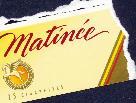
"The howl of affirmation."
|
- Michael Wade's journal, May 10, 1981:
"At about four the same morning, Ricky came home. He padded slowly up the stairs, smiling as if satisfied, smiling to see me home sprawled out on the couch, smiling at having just completed an entire adventure by himself. 'So where were you?' I asked.
"One side of his mouth rose higher, Ricky imitating a tough guy sneer: James Cagney home from the shoot out; a cocksure Jack Nicholson having just won at poker. 'Guess!' he said. We discussed our evenings, Ricky pulling out a torn piece of cardboard, one side of a Matinee cigarette package, with a signature and phone number on it --
"the sexy man at the pinball machine, the stares and smiles, narrow muscled hips in flirtatious stances, the exchange of occupations, the howl of affirmation, trust, the baring of teeth, softly clenched arms, shirts and waists caressed warmly, the walk, the hesitation, the thrusts, the jumps, knees and torso, arms and neck, the howl of affirmation, trust
"-- a torn piece of cardboard, one side of a Matinee cigarette package with a signature and phone number on it.
"'This going out separately, it can be a lot of fun,' Ricky said. I laughed, loving him."
Mikey had gone out on his own that night, too. He'd had a lousy time. I clearly did not. I might have provided some of the details Michael attributed to my adventure, though I think most were not mine but his own: he made everything into stories.
I do recall that inscribed cigarette pack, the place that man lived -- but nothing else, not how we met or even what he looked like. But I'm happy to be reminded that I was still going out.
"Don't you realize they could close us all down?! There'll be no place left to go! Nothing!"
George Hislop
to "I'm all right Jack" types one night at Buddy's.
At 3:00 that afternoon the police had struck again, busting The Back Door Gym and the old International Steam Bath on Spadina, the only two places missed in the February 5 raids. They had tried to be polite this time, protests and press coverage having had some effect. But 21 men were charged, bringing the total 1981 bath raid tally up to 337 arrests.
At least one man had now been arrested twice: David Newcome, in February at the Romans, both he and Paul Pearce regulars there; this time at The Back Door.
Lower level harassment had continued since the big raids. Four plainclothes cops had arrived at The Club one night, but went away when the doorman told them it wasn't "busy." Cruisers had kept the place under surveillance every night since February 5.
On May 10 cops showed up at 18 East, laying a charge of "overcrowding." The night before they had been at Dudes: same charge, the second one there since April 16. Attacks against individuals were widely reported, some brutal. Yet another man was charged with keeping a bawdy house in his bedroom, having brought home a man who turned out to be an undercover cop.
One night at Buddy's, George Hislop lost his cool in the face of a few "I'm all right Jack" customers: "Don't you realize they could close us all down?!" he shouted. "There'll be no place left to go! Nothing!"
On May 30 panic hit Edmonton: 60 men arrested at the Pisces Spa.
|
Naughty bits The Barracks Trial
Mysterious objects:
Obvious eroticism
|
|
More raids / More rage The Battle of Church Street
"Kill them!"
|
- "Dryly recited, robbed of context, described by a police officer in a court of law, the sexual play of gay men seemed as foreign and inert as the cockrings and dildos in their shiny plastic bags, each neatly labelled with an exhibit tag."
On the cover of that issue we had a gloved hand, gingerly dangling a baggie tagged: "Exhibit 'A' -- studded leather strap. Purpose unknown." It was here, in a two page news spread, that Smee Holzberg got to show the world his tempting package, exhibiting at least one known purpose of a snap-on cockring.
Protests continued, the latest at the police commission on May 2, after those conspiracy charges were laid against George Hislop and four others, among them Peter Maloney, a vocal police critic who happened to own shares in The Club. It seemed we were endlessly demonstrating.
And we would, again and again.
June 20, 10 pm: We gathered again at Yonge and Wellesley, 2,000 strong, again taking the street, this time north to Bloor and Yonge -- for a spontaneous five minute sit in. From there it was over to police HQ on Jarvis Street, where Roy McMurtry and chief Jack Ackroyd were burned in effigy. After that and the usual obligatory speakers the crowd dispersed peacefully, most along Charles Street.
The peace ended at Church and Charles. A gang of some 10 kids had shadowed the entire procession, yelling taunts. On Jarvis they'd hung around the north side of the demo, and when it broke up disappeared. They had gone down a laneway, found a picket fence and torn it apart for weapons.
As the crowd drifted along Charles these armed jerks ran down Church from the north and attacked. Cops were nowhere to be seen. People formed a quick phalanx. Paul Pearce threw poppers in one kid's face. Marshalls tried to hold the line back but it broke, people raging up Church Street after those kids, shouting "Kill them! Kill them!"
Then the police arrived, formed their own phalanx, pushing the crowd back from the north. They'd abandoned a cruiser behind them. People rushed in, rocked it. Then the clubs came out.
Brent Hawkes, pastor of the Metropolitan Community Church, trying to rescue someone who'd fallen, was hauled up by two cops, punched by a third. A cruiser sped out of Charles Street and up Church, bouncing Ken Popert off its hood without stopping. The final skirmish came at Yonge and Charles, a few straggling demonstrators there hurling rocks and abuse at cops.
This was "The Battle of Church Street," as Ken Popert later dubbed it. I'd lost Mikey in the fray, relieved at last to see him walking south holding onto Tim McCaskell, Tim's head bloody. We got down to the Wellesley Hospital, two others injured already there.
Police later reported to the press that they had caught those picket wielding kids. Records showed that of the six arrested, three had been demonstrators, one a woman who had come to the aid of someone being attacked, the others an 18 year old woman and a man, 42. Not a young het male among them. We reported all this in a special four page supplement, on the streets just days later. There wasn't a regular issue of The Body Politic due out for weeks.
It wasn't the first time we'd done a special in-between issue and would not be the last. Ever since December 30, 1977, when the police had raided our office at 5 pm on a Friday before a long weekend, they'd had a knack for timing their actions to avoid press attention. Or trying to.
Through all this, our legal cases dragged on. There was no action this year on our effort to get back the material seized in 1977; there wouldn't be until 1982, when we'd lose again and decide, for the moment, to let that issue drop.
In March, the day before a high court was to hear our appeal of the Crown's appeal of our acquittal (it was all endless appeals), Roy McMurtry had been quoted in The Toronto Sun saying gay leaders were "bent on confrontation" -- case in point: "Men loving boys loving men." Clayton Ruby, smelling an attempt to influence the course of justice, launched a suit. Yet another case, if short lived: the next day the Court of Appeal quashed the suit, ordering us to pay costs for both McMurtry and The Sun.
Three weeks later that court rejected our appeal of the Crown's appeal of our acquittal, so then we appealed to the Supreme Court of Canada. In October they said they wouldn't hear the case.
For us personally, all this went on off stage. But it meant we'd end up on stage again: in December we were ordered to retrial, the Press and its directors, Ken, Gerald and Ed, to be in court for Round Two: May 31, 1982.
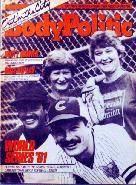
Play Ball!
|
Michael Riordon did a big piece on two men coming out into the macho world of Toronto's own Latin American community. In time gay people there would be among the most active in the city.
Performance artist (and McCaskell housemate) David Roche did an Upfront on playwright Sky Gilbert, whose Buddies in Bad Times Theatre would become one of the biggest queer stage companies anywhere. Robin Hardy chatted up Naked Lunch author William Burroughs.
Ken Popert covered the Cabbagetown Group Softball League, with photos quite engaging -- if I may say so: I took them. In one there's a delicious lanky blond with a big nose, just in shorts, running into base. His name was John; I later met him on the streetcar and got him into bed.
Chris Bearchell nimbly dissected a smelly CBC doc, "Sharing the Secret" -- her title for that "Trading on secrets." Her theme had much in common with an earlier Gary Ostrom cartoon, its caption: "OK, Rick, give me a sustained shot of the fairy with the bad skin, then we'll cut to the fat one with dirty hair for the interview about media manipulation." Robert Fulford, editor of Saturday Night, wrote to say Chris had produced "the most interesting piece about television I've read in a long time."
Also in this rude year, Gary offered tips on etiquette, in a strip called "Beyond the Vanderbelt." Its first rule: "Never fart in the presence of anyone wearing leather unless requested to do so first."
The year ended with TBP's 10th anniversary. On the cover of our celebratory issue were 39 Beepers (you can see them below), more than 650 others over the past decade listed inside, and 58 of the paper's 80 covers to date running along the bottoms of many spreads.
Gerald Hannon ended his personal tour of the paper and its people, "Who we were; Who we are," saying he'd spent "the last ten years with some of the people this generation will be remembered for. I want another ten."
That issue's lead news story reported another demo, the year's last: scores of protesters had disrupted a vote in the Ontario legislature on December 1, five handcuffing themselves to the public gallery railing. Amendments that would have included protection for gay people in the human rights code had been defeated. Again.
In the hall outside Paul Pearce ranted at Roy McMurtry, going on and on until Roy finally shouted, "It will never happen while I'm in office!" It didn't. Roy gave his words final punctuation: the attorney general of Ontario spat in Paul's face, turned on his heels and fled.
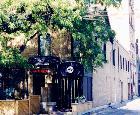
"Downtown faggots"
|
-
Michael Wade's journal, November 24, 1981:
"I've decided what I want my next job to be: working in a fancy restaurant, with a mostly gay staff, downtown. Sounds absolutely frivolous, doesn't it? I want to work in an environment that allows me to be a 'downtown faggot' working with other 'downtown faggots.' It's the only way I think I can get my ego in order."
Mikey had worked a series of odd jobs, in the mail room of an ad agency, at my old haunt The Book Cellar, and waiting in a few restaurants -- if none quite matching his criteria above. In time one did: Fenton's was the most upscale gay owned eatery in the city. Its standards would make Mikey a bit of a restaurant snob, often sniffing at service we got elsewhere.
It gave him another place to be gay, the staff almost entirely those "downtown faggots" he sought; the few not were mostly quite cued in heterosexual women, one of them Sara McCormack, his girlfriend when he and I met, all of us still friends. Some of Fenton's diners were gay too, if most too pretentious to be favourites of the staff.
Among the patrons one night were Roy McMurtry and his wife, Michael their dessert waiter. Roy ordered a chocolate mousse; Mrs McMurtry a raspberry foule. Michael paused, then nodded to each in turn: "A moose," he said, "and a fool."
Years later we'd see that couple at Buddies in Bad Times Theatre, Roy's politics likely softened by then. His son, not gay, often acted there; his daughter's work on offer too: Erin McMurtry grew up to be a noted lesbian playwright.
Roy McMurtry would become Chief Justice of Ontario. In 2003 he'd be among the judges of the Ontario Court of Appeals who ruled, unanimously, that Canada's "man & wife only" definition of "marriage" was an unconstitutional violation of human rights.
"I told him I had VD up my ass, but he said it was okay because he could fuck me using a condom. And sure enough, in a drawer, there was a whole box of condoms.
"The only faggot in the city with condoms, I swear."
I'll end this year with one of Mikey's tales. It's one many of us might have told, but he actually did, so here it is. The setting is Charly's, the disco over The St Charles, a Friday night, December 11, 1981. Michael had arrived at 11, way too early, but by now it was 10 minutes to closing.
- "By this time it was getting late, but Tina Weymouth (aka the Supreme Being) was being danced to, so I stood around to watch and listen. Then I'd go home. Okay.
"A very pretty clone turned a corner in front of me, then stopped dead. 'Hi-i...!' He was drunk or something. 'And ... how are yoo?'
"'Oh, just fine. Yeah, just fine.'
"'Oh good. You know, you are the first person I've been able to talk to, you know that? So how aaare yoo? Oh good!'
"He was smiling like a cutting knife and lowered his chin to the centre of his throat to look at me, then cocked his head, blinked and went on. 'You know, everybody here is soh snawby. Like, you go up to them and say hi-i, and they say nothing, they don't even look at you. I don't know. You gotta be pretty or something? I don't know. Oh, what's your name?'
"And I told him. 'I'm Don. You've got such nice eyes. Oh, I like you. I was in Vancoover two weeks ago? And they're soh nice out there. I slept with three people there in four days. But here, nothing. Even Whennipeg is better than this!'
"I was laughing too hard to listen to too much more. 'Where did you come from?!' I asked him facetiously.
"'Huh? What, nowhere. Here. You mean Whennipeg?'
"'So, you're just an enigma!'
"'Huh?'
"I howled again. Then he kissed me, right on the lips, using his tongue. 'Oh, I like you!' He whispered, 'I want to take you home and take care of you. Is that okay?'
"So, throwing caution to the wind -- or was it pearls before swine, I thought to myself, he may be dangerous, he may be a drunken dolt -- I made a bee line to the coat check."
Michael and this man went up the street for a take out order of chips, got giggled at by Manatee queens and then went to Don's place.
In his apartment, Michael recorded, there was "a chocolate brown sofa, a dining room table that needed finishing with four chairs arranged two by two, a crucifix on the wall, a glam coffee table, a spotless TV set. And nothing else." But in the bedroom there were bookcases stuffed with sheet music for piano: Lizst, Mozart, Brahms.
Don wanted to fuck Michael.
- "I told him I had VD up my ass, but he said it was okay because he could fuck me using a condom. And sure enough, in a drawer, there was a whole box of condoms."
Mikey's final line of that night's tale: "The only faggot in the city with condoms, I swear."
See 39 Beepers below!
Go on to Part Four: 1982-1986 A mysterious disease of unknown origin
Go back to: Contents page / My Home Page
This page: http://www.rbebout.com/bar/1981.htm
December 1999 / Last revised: June 16, 2003 / Minor corrections: August 11, 2007
Rick Bébout © 1999-2003 / rick@rbebout.com
